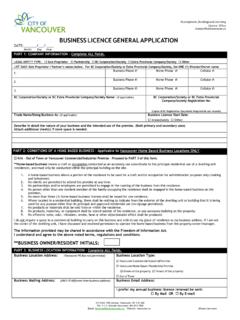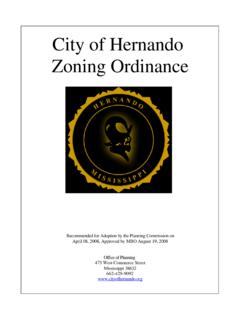Transcription of Guidelines for Additions, Infill and Multiple …
1 January 2018 City of Vancouver Land Use and Development Policies and Guidelines Planning, Urban Design and Sustainability Department 453 West 12th Avenue, Vancouver, BC V5Y 1V4 | tel: 3-1-1, outside Vancouver | fax: website: | email: | app: VanConnect Guidelines FOR ADDITIONS, Infill AND Multiple CONVERSION dwelling IN association WITH THE RETENTION OF A CHARACTER HOUSE IN AN RS ZONE Adopted by City Council on October 3, 2017 Amended January 16, 2018 City of Vancouver January 2018 Guidelines for Additions, Infill and Multiple Conversion dwelling Page i in association with the Retention of a Character House in an RS Zone Contents Page 1 Application and Intent .. 1 2 General Design Consideration .. 1 Character House Criteria .. 1 Character House Retention Requirements .. 2 Additions .. 2 3 Site Design and Tree Retention.
2 3 4 Uses .. 3 Multiple Conversion dwelling .. 3 Infill .. 3 5 Relaxations of Regulations of the Zoning and Development By-law .. 5 Site Area .. 6 Height .. 6 Ya r d s .. 6 Above-grade basement floor area exclusion in RS-3 and RS-3A .. 6 Site Coverage .. 6 Building Depth .. 6 External Design .. 7 6 Basements .. 7 7 Quality, Durability and Expression .. 7 8 Lane Frontage .. 7 9 Entrances and Access to dwelling Units .. 8 Multiple Conversion dwelling .. 8 Infill .. 8 10 dwelling Unit Density .. 9 11 Parking .. 9 12 Landscape Design .. 10 Street Frontage .. 10 Tree Protection, Retention and 10 Useable Open Space and Circulation .. 11 Lane Frontage .. 11 Garbage and Recycling .. 11 City of Vancouver January 2018 Guidelines for Additions, Infill and Multiple Conversion dwelling Page ii in association with the Retention of a Character House in an RS Zone City of Vancouver January 2018 Guidelines for Additions, Infill and Multiple Conversion dwelling Page 1 In association with the Retention of a Character House in an RS Zone 1 Application and Intent These Guidelines are to be used in conjunction with the RS district schedules of the Zoning and Development By-law and pertain to the approval of conditional floor area for additions to a character house, the approval of the conditional uses of Infill and Multiple conversion dwelling , and the approval of certain development relaxations, when associated with the retention of a qualifying character house.
3 The intent of the Guidelines is to ensure that: (a) renovations, alterations and additions to existing character houses maintain a form and character sensitive to the design of the original house; (b) additions, Infill , and conversion developments are respectful of the design of adjacent properties and provide a good fit with the overall neighbourhood; and, (c) site design considers and respects existing amenities, including trees and mature landscape. The Guidelines will be used to: (a) assist owners and applicants in designing developments; and, (b) provide a basis on which City staff evaluates projects for approval of conditional floor area, the conditional uses of Infill and Multiple conversion dwelling , and discretionary variations in regulations. 2 General Design Consideration Character House Criteria A character house is defined as an existing building that, in the opinion of the Director of Planning, has sufficient heritage character to justify its conservation.
4 A character house is typically a one family dwelling constructed prior to January 1, 1940 that meets the following character merit criteria as established by the Director of Planning. An assessment is required to determine if a house is considered to have character merit and a candidate for discretionary incentives in zoning, including conditional floor area, Infill or Multiple conversion dwelling , and development relaxations. The following are the minimum criteria: (a) Must have: (i) Original massing and primary roof form - Alterations/additions that are subsidiary to the original massing and primary roof form, such as dormers, are not considered to have altered the character of the house. (b) Plus any four of the following: (i) Entry - Original open front porch or veranda, or only partially filled in, or other original entry feature.
5 (ii) Cladding - Original cladding or replacement cladding consistent with the era when the house was built. (iii) Window Openings - Original location, size and shape (50 percent or more). The windows themselves may not be original. (iv) Period Details - Two or more period details, such as fascia, window casing or trim, eave brackets, soffits, exposed beam or joist ends, half-timbering, decorative shingling, porch columns, original wood doors, entry transom/sidelights, decorative or feature windows (special shapes, bay windows, crafted/leaded glass), brick or stone chimneys, piers or foundations, secondary porch, turrets, etc. (v) Streetscape Context - The house is part of a context of 2 or more character houses on the same block face (including the subject house). In assessing the streetscape, at least 2 houses on either side of the subject house should be included.
6 City of Vancouver January 2018 Guidelines for Additions, Infill and Multiple Conversion dwelling Page 2 In association with the Retention of a Character House in an RS Zone Pre-1940s buildings that have been severely altered and do not qualify as character houses may be considered for incentives, including Infill and/or conversion, if character elements are restored and reinstated as part of a development proposal. In special cases, a house built in 1940 or after that has particular architectural merit, and retains original and distinctive character features, may be considered a character house. In these cases, retention incentives may be supported on a case by case basis at the discretion of the Director of Planning. A character house is not required to be listed on the Vancouver Heritage Register. Houses listed on the Vancouver Heritage Register are eligible for the zoning incentives available to character houses, including conditional floor area, Infill or conversion, if meeting the above criteria.
7 Character House Retention Requirements To be eligible for incentives, including conditional floor area, Infill or conversion, the existing character house must be retained and restored to its original character as viewed from the street. At the pre-application stage, an assessment of the existing condition of the house will be undertaken by Planning staff to inform the amount of restoration required. This may include restoration of character elements, such as traditional window styles or opening up of entry porches that have been enclosed. The extent of restoration required will be determined by the scope of the proposal. Minimum expectations regarding the level of structural retention required in a character house undergoing major renovations and seeking conditional benefits in zoning are outlined in the Zoning By-law Administrative Bulletin: Retention and Renovation of Character Merit Buildings Scope and Documentation ( ).
8 Additions Additions should appear subordinate in visual prominence to the retained character house, as seen from the street. In general, additions should be located at the rear. Additions may extend to the side, noting that side additions should be set back from the front fa ade in order to create a clear distinction between old and new. Additions to the existing front facade are not supportable. Figure 1 Addition is set back from the front. This retains the original fa ade and minimises disruption to the streetscape Rear additions are not required to replicate the period or style of the original house; however, a high degree of design sensitivity should be brought to additions seeking an architectural expression that is distinct from the original house. Additions should be subordinate to the form and massing of the original house.
9 Large additions may be seen to overwhelm the original house form and compromise its character value. Therefore, the maximum floor space ratio may not be fully achievable through an addition when the existing character house is modest in size. In those cases, Infill may be a more supportable approach for the site. Flexibility is provided with regards to building depth for additions. See Section of these Guidelines . City of Vancouver January 2018 Guidelines for Additions, Infill and Multiple Conversion dwelling Page 3 In association with the Retention of a Character House in an RS Zone 3 Site Design and Tree Retention Existing trees and mature landscape are an important aspect of many character house sites, contributing to the character and amenity of the site and neighbourhood.
10 Tree retention strategies should be explored at an early stage in the site design. Character house projects and associated Infill , laneway houses or garages should be located and designed to preserve existing trees, where possible. Existing landscape features, such as stone walls, should also be retained, where possible. To retain significant trees, the Director of Planning may relax the regulations regarding the siting of buildings, and the required number of parking stalls. Alternately, some sites may not be considered suitable for Infill if significant tree removal is required. Utility connections and new landscape work such as driveways, walkways, patios, privacy fences and intensive plantings should be located to avoid disturbance of tree protection zones. Generally, site grading should respect the existing topography and provide compatibility with adjacent sites.














